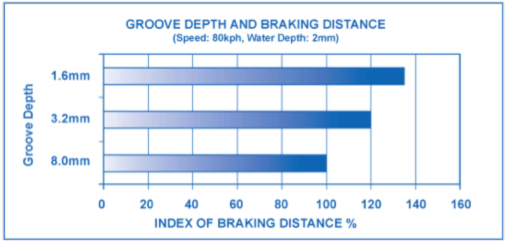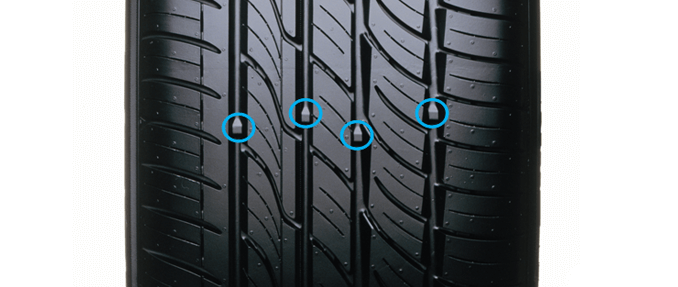What is the function of a tyre’s tread grooves?
The tyre's tread grooves disperse water away from the tyre's contact patch when roads are wet. Where tyres have insufficient tread depth, their ability to disperse water away from the tyre's contact patch when roads are wet is compromised, which can cause the driver to lose control of their vehicle.
Why is it essential to have tyres with sufficient tread depth?
When tyres have insufficient tread depth and can’t disperse water from the contact path they can become separated from the road surface. This is known as ‘aquaplaning’ or ‘hydroplaning’ and is very dangerous because the tyre cannot transmit steering, braking and necessary drive forces onto the road surface.
It is also a legal requirement for tyres to have a minimum tread depth of 1.5mm.
Standing water on wet roads reduces the size of a tyre's contact patch as shown in the image below. In extreme conditions, the tyre can "aquaplane" as highlighted above.
The tread depth of the tyre will determine how much the tyre's contact patch is reduced in wet conditions and therefore the amount of grip the tyres can provide. The graph below shows an example of how tyre tread depths affect braking distance on wet roads. When new, the tread depth of most passenger car tyres is close to 8.0mm. In Australia, for road worthy purposes, tyres with a tread depth 1.5 to 1.6mm are considered worn out. The graph below indicates the practical reason for this regulation.

How do I check the tread depth of my tyres?
All tyres have tread wear indicators moulded into the tread grooves, as shown below. When worn down to these indicators on any part of the tyre, the tyre should be replaced.
When checking the indicators for signs of wear, be sure to examine the whole tread area, including inside the tyre’s tread.
Check your tyres' inflation pressures at the same time as looking for signs of wear to ensure they are completely safe.

Safe driving tips for extreme weather conditions
Heavy rain
Regardless of the tread depth of your tyres, aquaplaning can occur during heavy rain due to the depth and volume of water on the road. Reduce speed and allow for extended braking distances to prevent loss of control and potential accidents.
First rain after a dry period
Regardless of the tread depth of your tyres, grip levels can be very low in the first rain after a long dry period. Drivers in tropical or drought-affected regions of Australia need to exercise caution and allow for extended braking distances to prevent loss of control and potential accidents.
